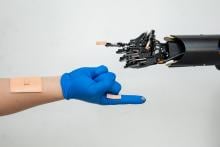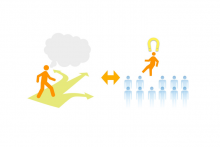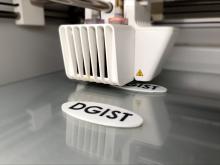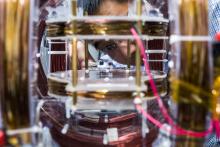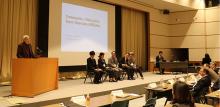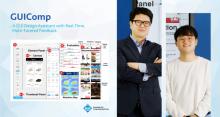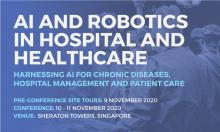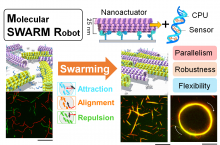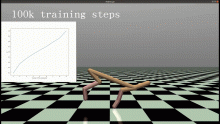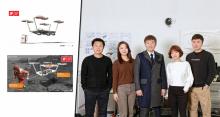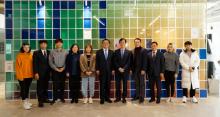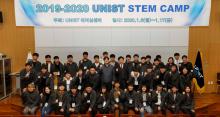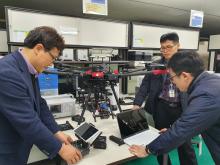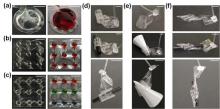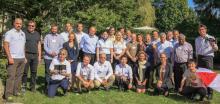Robots
News
23 Feb 2022
The coronavirus pandemic has accelerated the use of robots and an urgent need for an advanced human-machine interface (HMI) system that can seamlessly connect users and robots. A research team co-led by City University of Hong Kong (CityU) and collaborating institution recently developed an innovative HMI system, which consists of flexible, multi-layered electronic skin and provides both visual and haptic feedback to users. The system can teleoperate the robot to imitate the user's actions to perform complicated tasks. It demonstrates the potential for conducting Covid-19 swab tests and nursing patients with infectious diseases.
18 Feb 2022
Asia Research News monitors the latest research news in Asia. Some highlights that caught our attention this week are an android child, "unhackable" internet, a cancer-fighting nanoparticle from corn, and less-than-green practices by some oil companies.
01 Feb 2022
A new study provides a theoretical basis for the influence of learning from ancestors on the acceleration of natural selection using Fisher’s fundamental theorem
22 Nov 2021
The joint research team of Prof. Hongsoo Choi(DGIST) & Prof. Sung Won Kim(Seoul St. Mary’s Hospital), developed an hNTSC-based microrobot for minimally invasive delivery into the brain tissue via the intranasal pathway
29 Oct 2021
Researchers from The University of Tokyo Institute of Industrial Science find that drones may be the next generation of communication bases to monitor the ocean and seafloor because of their high-speed positioning, stability, and efficiency.
12 Aug 2021
The Targeted Neuronal Network Regeneration research group from the Department of Robotics Engineering at DGIST was selected
14 Jul 2021
Scientists develop a 3D-printed pressure sensor embedded with a temperature sensor from conductive carbon-based composites.
28 May 2021
A reimagined robot hand combines strength with resilience, sidestepping the problems that accompany existing designs.
13 May 2021
A spray-on magnetic coat turns any object into a robot controlled by a magnetic field. The biocompatible robots can walk, crawl and roll, and switch motions on demand.

01 Mar 2021
A joint research team co-led by City University of Hong Kong (CityU) has developed a new soft tactile sensor with skin-comparable characteristics. A robotic gripper with the sensor mounted at the fingertip could accomplish challenging tasks such as stably grasping fragile objects and threading a needle. Their research provided new insight into tactile sensor design and could contribute to various applications in the robotics field, such as smart prosthetics and human-robot interaction.
25 Feb 2021
Medical staff and researchers from Tohoku University and Fukushima Medical University conducted a collaborative, multifaceted training program for healthcare workers to better prepare them for disasters. The training incorporated a wide range of subjects such as data analysis, cultural revitalization in the wake of disasters, and post-disaster psychological and physical well-being.

11 Dec 2020
A joint research led by City University of Hong Kong (CityU) has built an ultralow-power consumption artificial visual system to mimic the human brain, which successfully performed data-intensive cognitive tasks. Their experiment results could provide a promising device system for the next generation of artificial intelligence (AI) applications.

25 Nov 2020
An easy way to make millirobots by coating objects with a glue-like magnetic spray was developed in a joint research led by a scientist from City University of Hong Kong (CityU). Driven by the magnetic field, the coated objects can crawl, walk, or roll on different surfaces. As the magnetic coating is biocompatible and can be disintegrated into powders when needed, this technology demonstrates the potential for biomedical applications, including catheter navigation and drug delivery.
20 Nov 2020
A research team, affiliated with South Korea's Ulsan National Institute of Science and Technology (UNIST) has introduced a novel responsive system, capable of molecular recognition of physicochemically similar mixtures, such as isotopes.
20 Nov 2020
A research team, affiliated with South Korea's Ulsan National Institute of Science and Technology (UNIST) has developed a deep learning-based AI system that can provide design recommendations regarding the best layouts through the assessment of graphical user interfaces (GUIs) of the mobile application.
14 Sep 2020
Scientists at Daegu Gyeongbuk Institute of Science and Technology, Korea, show that it is possible to distinguish between left-handed and right-handed people by noninvasively monitoring just their brain activity during passive tactile stimulation. These results are key in haptic research (the study of sensory systems) and have various important implications for brain–computer interfaces, augmented reality, and even artificial intelligence.
03 Sep 2020
Conference will see leading regional thought leaders, policymakers, C-suite officers, senior and middle level hospital and healthcare, e-health, clinical operations, medical and nursing professionals convene to explore new ways to innovate and collaborate.
12 Aug 2020
Forty-five of the world’s most influential leaders and innovators participated in EmTech Asia. They discussed how emerging technologies will influence industries related to artificial intelligence, robotics, sustainability, healthcare, immersive media, and more.
18 Jun 2020
Scientists are looking for ways to make millions of molecule-sized robots swarm together so they can perform multiple tasks simultaneously.
13 May 2020
Insights into a flipping crystal could further research into the development of autonomous robots.
06 May 2020
Scientists are finding safer ways to keep drug-loaded microrobots attached to cancer tissue.
23 Mar 2020
Human motor control has always been efficient at executing complex movements naturally, efficiently, and without much thought involved. This is because of the existence of motor synergy in the central nervous system (CNS). Motor synergy allows the CNS to use a smaller set of variables to control a large group of muscles; thereby simplifying the control over coordinated and complex movements.
06 Mar 2020
A design team, affiliated with South Korea's Ulsan National Institute of Science and Technology (UNIST) has been honored at the international design competition, iF Design Awards 2020.
25 Feb 2020
Mayor Cheol-ho Song (Ulsan, South Korea) visited the startup facilities of Ulsan National Institute of Science and Technology (UNIST) on January 4, 2020.
21 Feb 2020
South Korea's Ulsan National Institute of Science and Technology (UNIST) has held an enterance ceremony for the 2019-2020 UNIST STEM CAMP on January 6, 2020.
07 Feb 2020
A research group led by Professor Li Zhang, Associate Professor, Department of Mechanical and Automation Engineering at The Chinese University of Hong Kong (CUHK), has developed a strategy that selects the optimised bio-inspired microrobotic swarms in different bio-fluids. The swarms reported may have great potential in medical applications, and this work is an important intermediate step from a fundamental understanding of microrobotic swarms to their clinic applications. The related results have been published in Nature Communications, a prestigious international scientific journal.
29 Jan 2020
The technology analyzes water quality with drones and artificial intelligence to predict the level of algal bloom.
11 Nov 2019
Dr. Jinung An explores the human brain to discover the origin of ‘human hand motor skill.’
21 Oct 2019
DGIST Professor Sohee Kim’s Team developed a technology to produce 3D soft and flexible devices by blowing balloons made of polymeric thin films. Can be made in various 3D shapes... Expected to have diverse medical and biomedical applications.
09 Oct 2019
In the wake of major disasters, where structures collapse or people get trapped in hazardous situations, the first 72 hours are critical. Urban search and rescue teams, as well as first responders such as police and medical units, race against the clock to locate survivors, often at their own risk.
Events
Sorry, no events coming up for this topic.
Researchers
Sorry, no researchers coming up for this topic.
Giants in history
Sorry, no researchers coming up for this topic.


